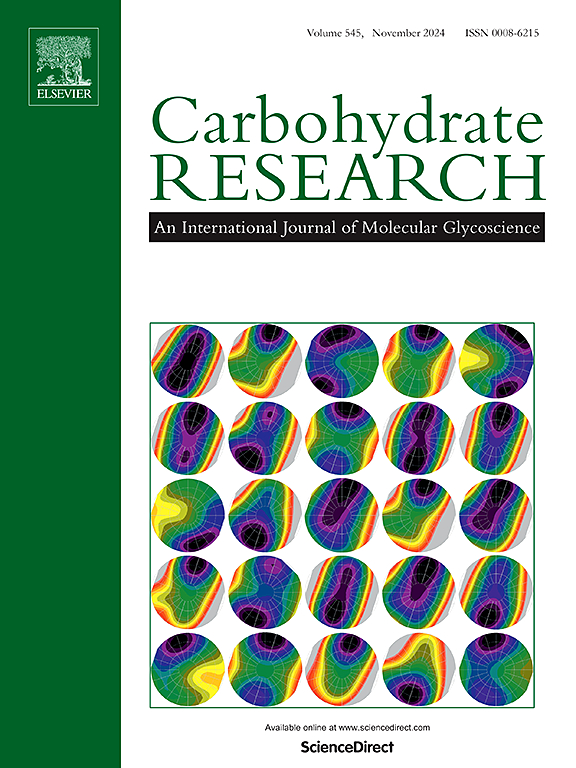2A,6A-F-Hepta-O-tert-butyldimethylsilyl α-cyclodextrin - A carbohydrate undecaol with all OH groups visible in NMR indicative of a partially disrupted hydrogen bond network.
IF 2.4
3区 化学
Q3 BIOCHEMISTRY & MOLECULAR BIOLOGY
引用次数: 0
Abstract
During a synthesis of the well-known and useful building block 6A-F-hexa-O-tert-butyldimethylsilyl α-cyclodextrin (2) by silylation of α-cyclodextrin (1) we isolated as a byproduct the oversilylated 2A,6A-F-hepta-O-tert-butyldimethylsilyl α-cyclodextrin (3) where one 2-OH group has also been silylated. This unsymmetrical new compound has a remarkable 1H NMR spectrum in CDCl3 where all 11 alcohol groups are visible. We have analyzed the spectrum of 3 using 1D and 2D 800 MHz NMR and are able to assign all the 11 alcohol protons. The remarkable chemical shifts of these protons are interpreted as being due to a partial disruption of an otherwise efficient hydrogen bond network.
2A, 6a - f -庚- o -叔丁基二甲基硅基α-环糊精-一种碳水化合物,所有羟基在核磁共振中可见,表明氢键网络部分断裂。
在通过α-环糊精(1)的硅基化合成众所周知的有用的构建块6a - f -六- o -叔丁基二甲基硅基α-环糊精(2)的过程中,我们分离出过硅基化的副产物6a - f -七- o -叔丁基二甲基硅基α-环糊精(3),其中一个2- oh基团也被硅基化了。这个不对称的新化合物在CDCl3中具有显著的1H NMR谱,其中所有11个醇基都可见。我们使用一维和二维800 MHz核磁共振分析了3的光谱,并能够分配所有11个醇质子。这些质子的显著化学位移被解释为是由于一个原本有效的氢键网络的部分破坏。
本文章由计算机程序翻译,如有差异,请以英文原文为准。
求助全文
约1分钟内获得全文
求助全文
来源期刊

Carbohydrate Research
化学-生化与分子生物学
CiteScore
5.00
自引率
3.20%
发文量
183
审稿时长
3.6 weeks
期刊介绍:
Carbohydrate Research publishes reports of original research in the following areas of carbohydrate science: action of enzymes, analytical chemistry, biochemistry (biosynthesis, degradation, structural and functional biochemistry, conformation, molecular recognition, enzyme mechanisms, carbohydrate-processing enzymes, including glycosidases and glycosyltransferases), chemical synthesis, isolation of natural products, physicochemical studies, reactions and their mechanisms, the study of structures and stereochemistry, and technological aspects.
Papers on polysaccharides should have a "molecular" component; that is a paper on new or modified polysaccharides should include structural information and characterization in addition to the usual studies of rheological properties and the like. A paper on a new, naturally occurring polysaccharide should include structural information, defining monosaccharide components and linkage sequence.
Papers devoted wholly or partly to X-ray crystallographic studies, or to computational aspects (molecular mechanics or molecular orbital calculations, simulations via molecular dynamics), will be considered if they meet certain criteria. For computational papers the requirements are that the methods used be specified in sufficient detail to permit replication of the results, and that the conclusions be shown to have relevance to experimental observations - the authors'' own data or data from the literature. Specific directions for the presentation of X-ray data are given below under Results and "discussion".
 求助内容:
求助内容: 应助结果提醒方式:
应助结果提醒方式:


